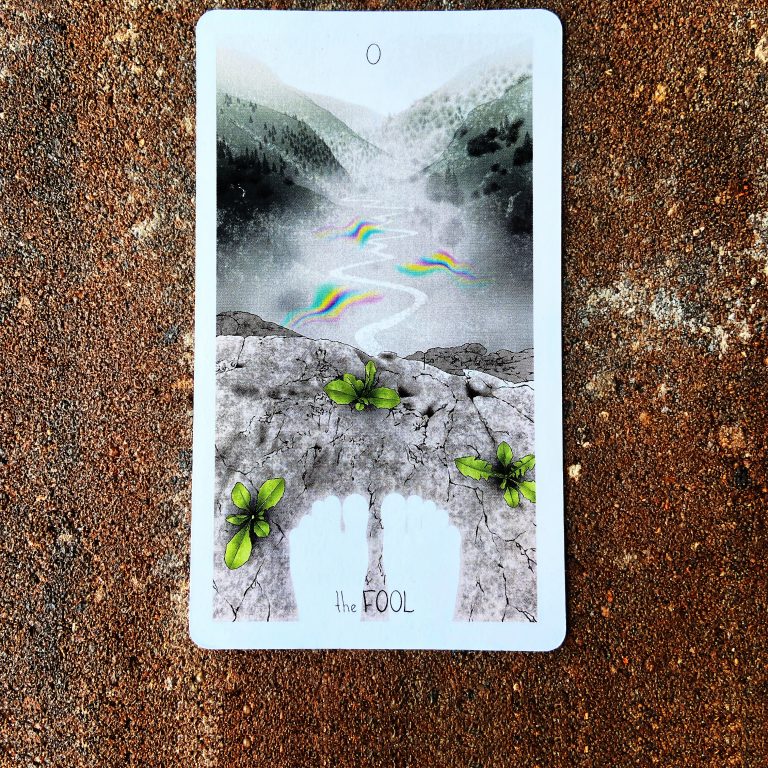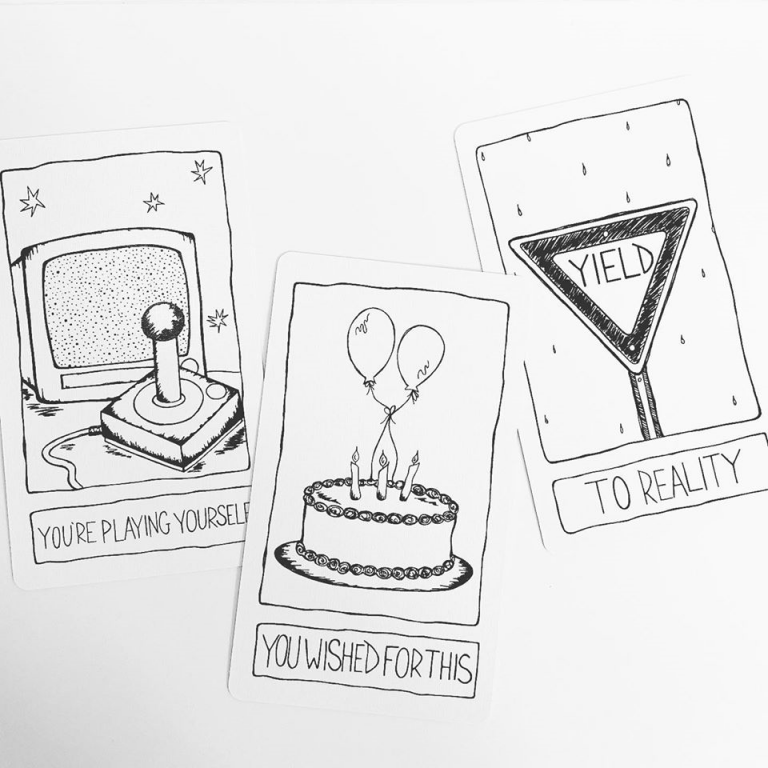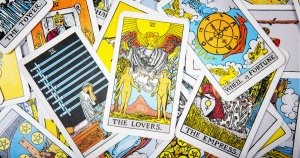 Stories are told in many ways. Writers use poems and novels; artists put paint on canvases. The history between tarot and literature is prominent and continues to inspire both art forms.
Stories are told in many ways. Writers use poems and novels; artists put paint on canvases. The history between tarot and literature is prominent and continues to inspire both art forms.
THE OLDEST TAROT DECK
Francesco Petrarca’s series of poems called Trionfi, or Triumphs (1351), mirrors the oldest tarot deck, Visconti di Modrone (15th century). The poem’s title is featured in the deck with 11 Triumph cards. Whether inspiration stemmed from Petrarca’s anthology is up to interpretation. Nevertheless, there are additional notions that lead many to believe his poetry inspired the earliest tarot designs because of his descriptions on Love, Chastity, Death, Fame, Time and Divinity. The Visconti Tarot collection, available at Beinecke Rare Book and Manuscript Library, Yale University can be found here.The Fool & Shakespeare
William Shakespeare’s various ‘fools’ characters are suspected to have influenced the tarot card that shares the same name: the Fool. In Shakespeare’s plays, the fool’s role is to entertain while cleverly commenting on the drama. In other words, this sensible character acknowledges nonsensical life events. With tarot, this card emulates the journey through life. The number 0 on the card reveals the unlimited potential to travel either to the beginning or end of the Major Arcana. The Fool’s spontaneous life experiences create a wise and free soul.
TAROT IN LITERATURE
Allegorical tarot figures often appear in literary pieces and vice versa. There are quite a few poets and writers who assemble their story’s theme(s) and characters based on tarot card meanings. William Butler Yeats, an Irish poet and avid tarot reader, was a member of an occult society called Hermetic Order of the Golden Dawn. Yeats deliberately tied tarot imagery into his poems like Blood and the Moon and The Fool by the Roadside.Blood and the Moon:
The Moon tarot revolves around illusion. The card’s artwork depicts a moon that sits in between two towers. This describes a misunderstanding or the inability to accept the truth. Yeat’s poem references the moon’s innocence and how it cannot be stained by blood: The purity of the unclouded moon Has hung its arrowy shaft upon the floor. Seven centuries have passed and it is pure, The blood of innocence has left no stain The Tower tarot often symbolizes danger, crisis, unanticipated change and liberation. It is believed that in this poem, the tower symbolizes Yeats himself: I declare this tower is my symbol; I declare This winding, gyring, siring treadmill of a star is my ancestral stair
The Fool by the Roadside:
Fool by the Riverside is brief and follows the rhyme scheme AABCCB, which is categorized as simple, juvenile, and in a way, foolish. In this poem, the Fool believes that life can spool backward and forward. This strongly relates to the Fool tarot card, which can appear either at the beginning or end of a deck. It is clear that both Yeat’s character and the tarot symbol are similar in the sense that they can exist in any direction or environment. When all works that have From cradle run to grave From grave to cradle run instead; When thoughts that a fool Has wound upon a spool Are but loose thread, are but loose thread; When cradle and spool are past And I mere shade at last Coagulate of stuff Transparent like the wind, I think that I may find A faithful love, a faithful love. W.B. Yeats is one of the most influential tarot poetry writers. He sought to implement allegorical imagery in a subtle way. This is because his involvement in Golden Dawn was a secret and exposing the organization and its members were strictly not in the cards.
The Waste Land by T.S. Eliot
While a poet may intentionally create specific themes, concepts and imagery, most of the time the poem’s deeper meaning and overall analysis fall on the reader to interpret. That is the beauty of literature; we speculate and dissect a piece until it makes sense to us. For example, in the poem “The Waste Land,” some believe that the drowned Phoenician Sailor is a reference to the Ten of Swords card and the Lady of the Rocks is the Queen of Cups. But the more obvious tarot indications by Eliot are the mention of The Hanged Man and the Wheel (The Wheel of Fortune).
The Connection
There are various ways to read poetry, but the basics include identifying the narrator and the tone as well as interpreting the deeper picture and overall theme. While reading poetry, you discover themes, understand the basic text and find a deeper meaning. Tarot cards have visuals, symbols and meanings presented to you. Both tarot and literature require you to interpret beyond what you are given. You are urged to find connections amid the metaphors, images, text, archetypes and more. Their similarities allow you to use one art form, like poetry to better understand the other: tarot.Caos del Triperiuno
Among the first writers to feature tarot in poetry was Teofilo Folengo. In 1527, he wrote a poem called Caos del Triperiuno. The poem itself revolves around a poet who accompanies four people into a room where they each choose a fate-related tarot card. The poet then writes a poem that connects the person to the tarot card drawn. Tarot Cards Featured in Folengo’s Poem:- The 22 Major Arcana, or trump cards: The Fool (0), The Magician (I), The High Priestess (II), The Empress (III), The Emperor (IV), The Hierophant (V), The Lovers (VI), The Chariot (VII), Strength (VIII), The Hermit (IX), Wheel of Fortune (X), Justice (XI), The Hanged Man (XII), Death (XIII), Temperance (XIV), The Devil (XV), The Tower (XVI), The Star (XVII), The Moon (XVIII), The Sun (XIX), Judgement (XX), The World (XXI)
- Major Arcana Meaning: A tarot reading with these cards use one’s soul to explore their long-lasting life changes.
The Breakdown:
Mary K. Greer, writer and professional tarot consultant, labeled each tarot card mentioned in Folengo’s poem: Love, under whose Empire many deeds (VI; IV) go without Time and without Fortune, (IX; X) saw Death, ugly and dark, on a Chariot, (XIII; VII) going among the people it took away from the World. (XXI) She asked: “No Pope nor Papesse was ever won (V; II) by you. Do you call this Justice?” (XI) He answered: “He who made the Sun and the Moon (XIX; XVIII) defended them from my Strength. (VIII) “What a Fool I am,” said love, “my Fire, (O; XVI) That can appear as an Angel or as a Devil (XX; XV) can be Tempered by some others who live under my Star. (XIV; XVII) You are the Empress of bodies. But you cannot kill hearts, (III) you only Suspend them. You have a name of high Fame, (XII) but you are nothing but a Trickster.” (I)Judgment & Devil


Temperance & Star
can be Tempered by some others who live under my Star (XIV; XVII) The following sentence uses the Temperance card to reassure that although the choice between acting as an angel or a devil is difficult, you will find peace and balance through the people who love and care about your soul. This reveals that you need assistance from the people who you trust. Your life will transform as well as those who follow close to you. After all, our life decisions impact every single person in our circle or Star.
The Empress, The Hanging Man & The Magician
You are the Empress of bodies. But you cannot kill hearts, (III) you only Suspend them. You have a name of high Fame, (XII) but you are nothing but a Trickster.” (I) The Empress tarot card connects you to the natural world. Our soul consists of the Empress’ teachings and strength, but our self-expression is not always filled with positivity. The connecting theme throughout this poem is Love and Death, where Death has control over suspending the physical body (The Hanging Man card), but Love can never die. The speaker refers to Death as a Trickster or a fraud. This embodies the Magician tarot card, which manifests dreams and magic into one’s reality.Tarot Poetry
Poetry and tarot have leaned on one another to further develop their respective craft. Without poetry, the modern tarot cards we use today may look completely different, or perhaps not exist at all. And without tarot, literary storylines, themes and characters would lack allegorical symbols and meanings. After all, when we allow art to inspire art, we gain access to groundbreaking work. Here are some of our clients’ custom tarot card designs, equipped with personalized designs, number of cards, instructions and more.

The Spiritful Tarot deck is complete with 78 custom-designed cards, an instructions booklet and a two-part box.

This nature-themed deck follows the conventional Tarot layout. Featured above are the King of Pentacles and the Page of Pentacles.


The Dark Exact Tarot deck — Illustrated and designed by Coleman Stevenson. The cards above are the Fool, the Magician and The High Priestess.

Postcards From the Liminal Space guides, comforts and aids on your journey through life.

The Vulture Tarot is a vibrant deck that radiates spooky vibes.
● Official Shuffled Ink website: ShuffledInk ● Make Your Own Custom Tarot Cards at: ShuffledInk





















